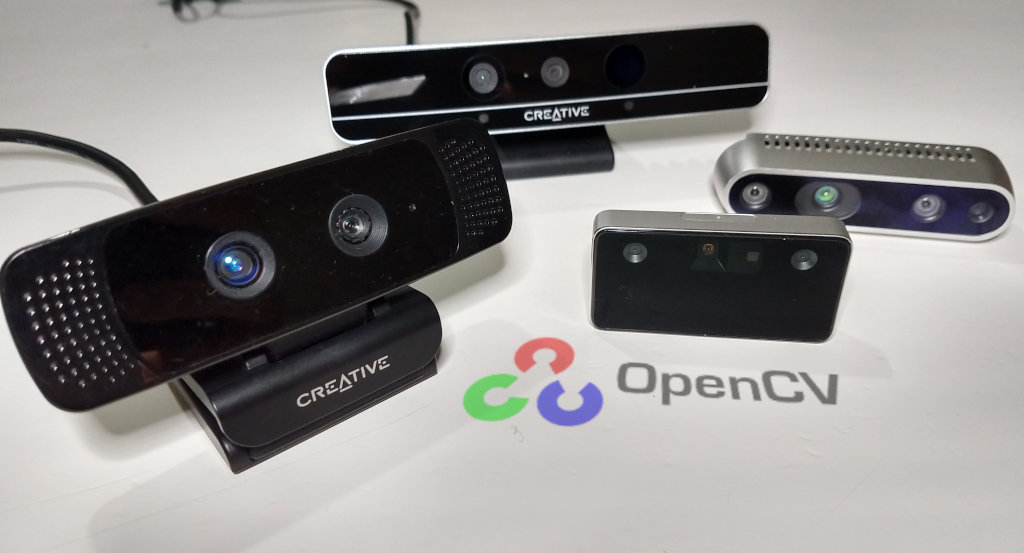Prev Tutorial: Using Orbbec 3D cameras (UVC)
Next Tutorial: Using Wayland highgui-backend in Ubuntu

hardwares
Note: This tutorial is partially obsolete since PerC SDK has been replaced with RealSense SDK
Depth sensors compatible with Intel® RealSense SDK are supported through VideoCapture class. Depth map, RGB image and some other formats of output can be retrieved by using familiar interface of VideoCapture.
In order to use depth sensor with OpenCV you should do the following preliminary steps:
- Install Intel RealSense SDK 2.0 (from here https://github.com/IntelRealSense/librealsense).
- Configure OpenCV with Intel RealSense SDK support by setting WITH_LIBREALSENSE flag in CMake. If Intel RealSense SDK is found in install folders OpenCV will be built with Intel Realsense SDK library (see a status LIBREALSENSE in CMake log).
- Build OpenCV.
VideoCapture can retrieve the following data:
- data given from depth generator:
- CAP_INTELPERC_DEPTH_MAP - each pixel is a 16-bit integer. The value indicates the distance from an object to the camera's XY plane or the Cartesian depth. (CV_16UC1)
- CAP_INTELPERC_UVDEPTH_MAP - each pixel contains two 32-bit floating point values in the range of 0-1, representing the mapping of depth coordinates to the color coordinates. (CV_32FC2)
- CAP_INTELPERC_IR_MAP - each pixel is a 16-bit integer. The value indicates the intensity of the reflected laser beam. (CV_16UC1)
- data given from RGB image generator:
- CAP_INTELPERC_IMAGE - color image. (CV_8UC3)
In order to get depth map from depth sensor use VideoCapture::operator >>, e. g. :
for(;;)
{
Mat depthMap;
capture >> depthMap;
break;
}
int waitKey(int delay=0)
Waits for a pressed key.
@ CAP_REALSENSE
Synonym for CAP_INTELPERC.
Definition: videoio.hpp:118
For getting several data maps use VideoCapture::grab and VideoCapture::retrieve, e.g. :
for(;;)
{
Mat depthMap;
Mat image;
Mat irImage;
capture.grab();
break;
}
@ CAP_INTELPERC_DEPTH_MAP
Each pixel is a 16-bit integer. The value indicates the distance from an object to the camera's XY pl...
Definition: videoio.hpp:645
@ CAP_INTELPERC_IR_MAP
Each pixel is a 16-bit integer. The value indicates the intensity of the reflected laser beam.
Definition: videoio.hpp:647
@ CAP_INTELPERC_IMAGE
Definition: videoio.hpp:648
For setting and getting some property of sensor` data generators use VideoCapture::set and VideoCapture::get methods respectively, e.g. :
@ CAP_PROP_FPS
Frame rate.
Definition: videoio.hpp:147
@ CAP_INTELPERC_DEPTH_GENERATOR
Definition: videoio.hpp:639
@ CAP_PROP_INTELPERC_PROFILE_IDX
Definition: videoio.hpp:630
Since two types of sensor's data generators are supported (image generator and depth generator), there are two flags that should be used to set/get property of the needed generator:
- CAP_INTELPERC_IMAGE_GENERATOR – a flag for access to the image generator properties.
- CAP_INTELPERC_DEPTH_GENERATOR – a flag for access to the depth generator properties. This flag value is assumed by default if neither of the two possible values of the property is set.
For more information please refer to the example of usage videocapture_realsense.cpp in opencv/samples/cpp folder.


